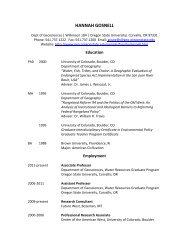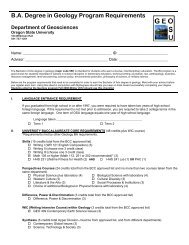Peace on the River? Social-Ecological ... - Water Alternatives
Peace on the River? Social-Ecological ... - Water Alternatives
Peace on the River? Social-Ecological ... - Water Alternatives
You also want an ePaper? Increase the reach of your titles
YUMPU automatically turns print PDFs into web optimized ePapers that Google loves.
<strong>Water</strong> <strong>Alternatives</strong> - 2010 Volume 3 | Issue 2<br />
state border. The two sub-basins, which collectively cover 40,000 km 2 , are nearly equal in size, but vary<br />
significantly geographically and ecologically.<br />
The basin’s headwaters are in <strong>the</strong> eastern Cascade Mountains, where three major tributaries wind<br />
<strong>the</strong>ir way through forest and ranch land and c<strong>on</strong>verge at Upper Klamath Lake. Until <strong>the</strong> 20th century,<br />
much of <strong>the</strong> UKB comprised wetlands, and served as an important stopover <strong>on</strong> <strong>the</strong> Pacific Flyway.<br />
Historically, salm<strong>on</strong> migrated from <strong>the</strong> Pacific Ocean all <strong>the</strong> way up into <strong>the</strong> tributaries above Upper<br />
Klamath Lake, but <strong>the</strong> Copco 1 dam blocked passage in 1918. This arid, high-elevati<strong>on</strong> regi<strong>on</strong> has been<br />
Klamath Tribes’ territory for thousands of years (Most, 2006). The Klamath Tribes ceded over 8 milli<strong>on</strong><br />
ha of <strong>the</strong>ir homeland for a reservati<strong>on</strong> of 800,000 ha in <strong>the</strong> Treaty of 1864; importantly, <strong>the</strong>y reserved<br />
hunting and fishing rights across <strong>the</strong> reservati<strong>on</strong> and <strong>the</strong> ceded lands. These rights have been<br />
determined by subsequent interpretati<strong>on</strong> of <strong>the</strong> treaty to include <strong>the</strong> right to sufficient in-stream flows<br />
to support two species of sucker fish, now endangered, <strong>on</strong> which <strong>the</strong>y have historically depended for<br />
physical and spiritual sustenance. The Klamath Tribes were terminated in 1954, al<strong>on</strong>g with many o<strong>the</strong>r<br />
tribes in <strong>the</strong> US, as part of federal assimilati<strong>on</strong> policy. 5 Terminati<strong>on</strong> was disastrous for <strong>the</strong> Klamaths due<br />
to <strong>the</strong> loss of <strong>the</strong>ir reservati<strong>on</strong>. In 1986, tribal status was restored, but no land was returned (Doremus<br />
and Tarlock, 2008).<br />
The UKB is also now home to a number of close-knit agricultural communities, which developed as<br />
part of <strong>the</strong> wave of immigrati<strong>on</strong> into <strong>the</strong> western US in <strong>the</strong> late 1800s, and explicit federal policies<br />
designed to attract and encourage settlement and land c<strong>on</strong>versi<strong>on</strong> for agricultural producti<strong>on</strong> in <strong>the</strong> era<br />
between World War I and World War II. As described below, <strong>the</strong>se communities are largely dependent<br />
<strong>on</strong> <strong>the</strong> water of <strong>the</strong> Klamath basin for irrigati<strong>on</strong> of extensive cattle pasture, alfalfa, and crops, including<br />
potatoes, horseradish, <strong>on</strong>i<strong>on</strong>s, and mint (Braunworth et al., 2002).<br />
Below Upper Klamath Lake, <strong>the</strong> Klamath river flows past <strong>the</strong> hydroelectric dams and into <strong>the</strong> LKB,<br />
where it is joined by <strong>the</strong> Scott, Shasta, Salm<strong>on</strong>, and Trinity rivers before emptying into <strong>the</strong> Pacific<br />
Ocean. The LKB, mostly rugged, temperate rainforest, was <strong>on</strong>ce <strong>the</strong> third most productive salm<strong>on</strong> river<br />
system in <strong>the</strong> lower 48 states, but habitat-blocking dams, poor water quality and insufficient flows have<br />
reduced <strong>the</strong> salm<strong>on</strong> populati<strong>on</strong> to less than 10 percent of its historic size, harming <strong>the</strong> tribes as well as<br />
commercial and recreati<strong>on</strong>al fishing communities. The LKB is still home to three salm<strong>on</strong> fishing tribes,<br />
<strong>the</strong> Yurok, Karuk, and Hoopa Valley. The Yurok and Hoopa Valley Tribes both have treaty fishing rights,<br />
which "include <strong>the</strong> right to prevent o<strong>the</strong>r appropriators from depleting <strong>the</strong> streams’ waters below a<br />
protected level" (Woodward and Romm, 2002). 6<br />
<strong>Ecological</strong> transformati<strong>on</strong> and water development<br />
Much of <strong>the</strong> current c<strong>on</strong>flict in <strong>the</strong> basin can be traced to European-American development and<br />
settlement projects, many of <strong>the</strong>m initiated and supported by state and federal governments, that<br />
significantly transformed and degraded <strong>the</strong> ecological functi<strong>on</strong>ality and fisheries productivity of <strong>the</strong><br />
Klamath system.<br />
During <strong>the</strong> mid-to late 1800s, ranchers and farmers settled in <strong>the</strong> valleys above Upper Klamath Lake<br />
and claimed water under <strong>the</strong> state prior appropriati<strong>on</strong> doctrine, a system of 'first come, first served'<br />
water allocati<strong>on</strong> used throughout <strong>the</strong> western US. The oldest claimants in <strong>the</strong> basin, however, are <strong>the</strong><br />
Klamath Tribes, whose reserved water rights, which stem from <strong>the</strong>ir hunting and fishing treaty rights,<br />
date from 'time immemorial' (US v. Adair, 478 F. Supp. 336, 345 (D. Or. 1979) (Adair I)). Both <strong>the</strong><br />
Klamath Tribes and <strong>the</strong> lower basin tribes have asserted treaty rights to in-stream water flows needed<br />
to support treaty species. Put simply, <strong>the</strong> tribes want to maintain water in-stream for fish, and irrigators<br />
5 Terminati<strong>on</strong> was <strong>the</strong> policy of <strong>the</strong> US from <strong>the</strong> mid-1940s to <strong>the</strong> mid-1960s due to <strong>the</strong> belief of C<strong>on</strong>gress that Native<br />
Americans would be better-off assimilated into mainstream society. In additi<strong>on</strong> to loss of tribal land, terminati<strong>on</strong> involved loss<br />
of tribes’ status as sovereign nati<strong>on</strong>s able to negotiate with <strong>the</strong> federal government <strong>on</strong> even footing.<br />
6 From footnote (page 344) in Woodward and Romm (2002), this quote is from: Solicitor Opini<strong>on</strong>, 1995, citing Joint Board of<br />
C<strong>on</strong>trol, 832 F.2d at 1131-1132; Adair, 723 F.2d at 1411; and also Kittitas Reclamati<strong>on</strong> District, 763 F.2d at 1033.<br />
Gosnell and Kelly: Dam removal in <strong>the</strong> Klamath basin Page | 367






